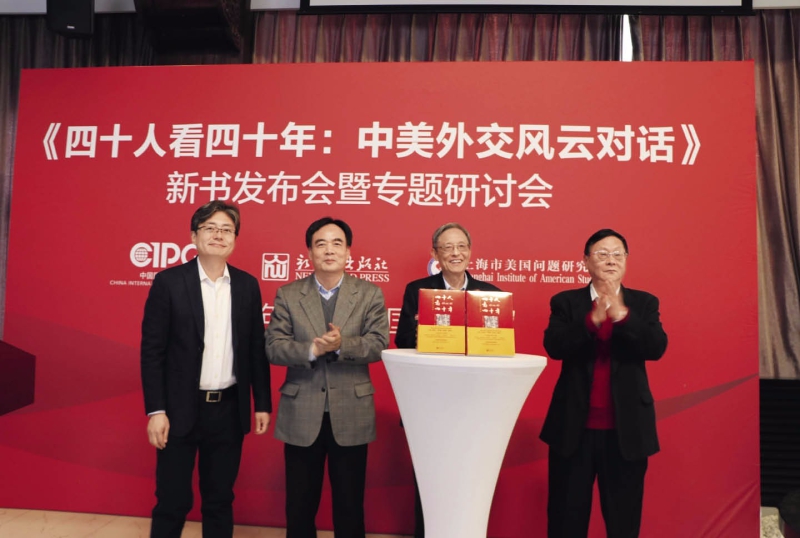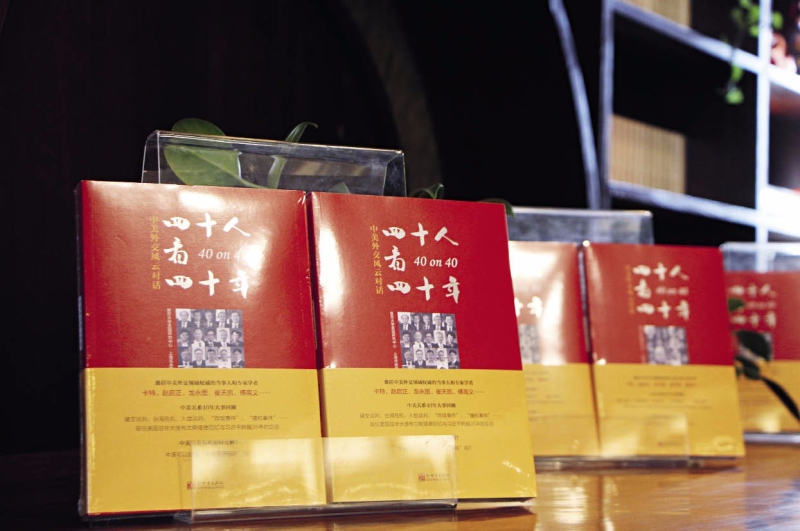On December 23, 2019, a launching ceremony of the book 40 on 40, a collection of dialogues with 40 experts on China-U.S. diplomatic relations, is held in Beijing.

On December 23, 2019, a launching ceremony of the book 40 on 40, a collection of dialogues with 40 experts on China-U.S. diplomatic relations, is held in Beijing.
However, the fact that China and the U.S. recently reached agreement on a phase-one trade deal shows that when both sides demonstrate good faith, work in concerted efforts and communicate as equals, solutions can always be found to any issue.
As of the end of 2019, a launching ceremony of the book 40 on 40, a collection of dialogues with 40 experts on China-U.S. diplomatic relations, was held in Beijing. China Today interviewed some of the attendees and found that even amid escalating trade friction, they still believe that an attitude of win-win cooperation and bilateral dialogues can solve the disputes between the two sides.
Bilateral Relations Based on Common Interests
Zhou Wenzhong was one of the first diplomats the People’s Republic of China sent to the United States after the two sides established diplomatic relations in the late 1970s. He served as the eighth Chinese ambassador to the U.S. Zhou has witnessed many ups and downs in bilateral relations.
In December 1978, China and the U.S. declared that they were about to establish diplomatic relations. “It was also the time when I got the job transfer to Washington D.C. In January 1979, I officially started my job as a translator for the then Chinese ambassador to the U.S.,” Zhou recalled.
Back then, he could see a wave of sentiments in the U.S. from ordinary people to senior officials, all interested in China.
“The U.S. government sought to strengthen economic ties with China in its own interests; while American companies and its people gradually got a favorable impression of China. In such circumstances, we managed to hold an exhibition of China’s historic relics, which soon became a must-see event among locals. Later a pair of Chinese pandas were also delivered as a national gift.”
All these actions, said Zhou, were warmly received by Americans. Even after a long period of isolation and hostility, he felt that a friendship was deeply rooted in the hearts of the two peoples.
China and the U.S. do have differences on some issues, Zhou observed, many of which are fundamental as the two sides adopt different political institutions and social systems. Moreover, uncertainties were frequently seen in the American foreign policy toward China after Donald Trump took over the presidency.
Trump’s victory in the last presidential election, to some extent, was an outcome of American-style democracy, the voice of American voters and a reflection of its domestic political ecology.
Zhou said that tracing back in history it is easy to discover that America has been changing its foreign policy toward China based on its national interests since the Carter administration in the late 1970s and early 1980s. When former President Bill Clinton took office after the upheaval of the Soviet Union, he highlighted the democratic values in the Western world as the backbone of his diplomatic policy; while during his second term, he switched to offer the most favored nation status to China without any conditions. His successor George Walker Bush soon dismissed Clinton’s talk of China as a “strategic partner” rather seeing the Asian giant as a “strategic competitor.”
However, according to Zhou, the September 11 attacks on the U.S. sounded the alarm for Bush, who needed China’s support to fight against terrorism. A common interest in countering terrorism led to relatively smooth development of bilateral relations during the two terms of Bush’s presidency. The Obama administration adopted a policy of rebalancing toward Asia, which is known as “Pivot to Asia” policy, as he pulled U.S. troops back from Iraq and Afghanistan. “In the era of Trump, the U.S. has an intensifying fear of China’s rise given its declining overall national strength, and thus spares no efforts to contain China,” Zhou said.
Whatever vicissitudes the bilateral relations have encountered over the past four decades, it is not easy for both sides to make today’s achievements. Based on their comparative strengths, the two countries have built up a mutually beneficial relationship, which is a fundamental characteristic of China-U.S. relations, said Zhou.
“China is the world’s biggest developing country and the United States is the biggest developed country. A sound relationship is not easily won and is of great significance to both sides. Dialogues and cooperation should always be the mainstream of our bilateral relations,” the former ambassador concluded.

The front cover of the book 40 on 40.
Close Economic Ties
He Weiwen once worked as the economic and commercial counsellor of the Consulate-General of China in San Francisco and later in New York City between 1997 and 2003. He is a pioneer in promoting the cooperation between some American states and dozens of Chinese provinces and cities, and expanding a potential market for many domestic companies.
He said trade in goods between China and the U.S. in 2016 amounted to US $519.6 billion, then US $583.7 billion and US $633.5 billion in the next two years respectively. It can be clearly seen that the two-way trade in goods has grown consistently before 2019. In 2017 for example, bilateral trade figure reached a 233-fold increase from 1979 when the two countries forged diplomatic ties, as well as a seven-fold increase from 2001 when China acceded to the World Trade Organization. However, it is estimated that the two-way trade in goods in 2019 may fall back to the level of 2016, said He.
In 2019, the European Union maintained its position as the largest trade partner of China, but the U.S. was replaced by the Association of Southeast Asian Nations and slid to third ranking. It seemed that a tit-for-tat trade dispute launched by the Trump administration has not forced the Chinese government to yield to U.S. demands.
According to He, reflecting on the history of the China-U.S. economic ties over the past four decades shows the U.S. has gained substantially from it. Based on the 2017 report released by Oxford Economics and U.S.-China Business Council, trade in goods between China and the U.S. in 2015, and two-way investment in total created 2.6 million jobs in the U.S., boosted the U.S. economy by 1.2 percentage points, and saved an average of US $850 for each American family annually. Statistics also show that in 2017, the U.S. auto maker General Motors sold more than four million vehicles in China, outnumbering its domestic sales for six consecutive years. In the same year, the sales volume of American enterprises in China exceeded US $600 billion. He said the figures are convincing evidence that China has offered a gigantic market and generous financial rewards to the U.S.
“In spite of ups and downs, the China-U.S. economic ties are grounded in economic law and based on the interests of two peoples. No political leader is able to shake such close ties,” said He.
Wisdom Gained from Think Tanks
Diao Daming, an associate professor at the School of International Studies with the Renmin University of China, is a typical young academic on China-U.S. relations. He looks at the U.S. foreign policy and relations with China from the perspective of the country’s domestic politics.
A frequent visitor to Washington D.C., the Beijing-based academic maintains close contacts with both Republican and Democratic experts of American think tanks. In his eyes, The National Security Strategy of the United States of America unveiled at the end of 2017 showed that the U.S. academic circle reached a consensus that China is a “strategic competitor.” ”So the next question on their minds is how to deal with China,” Diao explained. Trump has thus tested China’s reactions in multiple areas and accordingly readjusted his foreign policy, said Diao. He believes China should take the initiative in responding to those tentative provocations and “modify the recognition of our counterparts.”
He shared his views on possible countermeasures China can take.
“First, we should express our sincere wishes to promote steady development of bilateral relations, repeatedly underlining our pursuit of ‘no conflict or confrontation, but mutual respect and win-win cooperation’ policy,” he said, adding that it is also important that China makes an explicit and strategic explanation of its demands, core interest and the bottom line to the U.S. and beyond.
“This means that we should make powerful and effective responses to all the economic and trade disputes, including those sensitive ones that might lead to new challenges. The U.S. should stop acting on its own will, and instead keep a clear mind that the biggest challenge comes from its domestic affairs. Wrestling with China is just wasting time and would have an adverse impact on itself,” he said.
Diao shared another interesting finding in his studies. People in the electoral districts for House of Representatives are benefiting from China-U.S. trade ties, he said. “Exports to China are increasingly creating more jobs for local people. Given this, congress members representing these districts are very likely to stay away from agendas involving hostile policies to China,” Diao explained.
These electoral districts include the hinterland of the United States, such as the southern states at the lower reaches of the Mississippi River, and the Rocky Mountains region, and southwest regions, home to a large number of Mexican Americans and other Latin Americans, according to him. “It is obviously an opportunity for China to get in touch with people in these vast areas and their people,” he said.